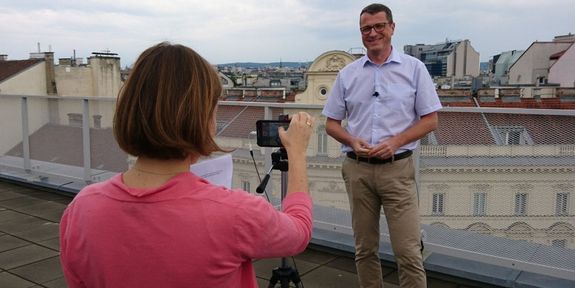The European Open Science Cloud (EOSC) initiative was launched by the European Commission to provide support to more than 1,7 million researchers and boost interdisciplinary research in Europe. It fosters data sharing and the implementation of a trusted and open distributed environment for the scientific community providing seamless access to data and interoperable services addressing the whole research data life cycle. The development of the EOSC realises EU policy objectives including Open Science, FAIR data implementation, and the Digital Single Market. Researchers are at the very heart of the EOSC. So, what do our researchers say almost one year after the launch of the initiative? How do they think will they will benefit from the EOSC? What are and what can be their roles? Let’s see what TU Wien professor and researcher Wolfgang Wagner has to say.
Interview with Wolfgang Wagner
Professor für Remote Sensing and Head of the Department of Geodesy and Geoinformation, opens an external URL in a new window at the TU Wien; Co-founder and Senior Researcher at the EODC Earth Observation Data Centre, opens an external URL in a new window
Data become more valuable when many scientists from around Europe work with one and the same dataset
Can you please describe your field of research?
We work with earth observation satellite data in order to understand global environmental processes. We try to understand how climate change affects the environment. Our main focus is on radar data and we look specifically at how hydrological variables like soil moisture or water bodies change over time.
What is the main challenge you currently face?
The main challenge is that our data are becoming more and more complex and the volume of our datasets become larger. For example, we work with the Sentinel-1 satellites which provide several terabytes of data every day. Accumulated over the lifetime of a satellite, this means we have hundreds of terabytes of raw data and when we process the data, they become petabytes of data.
Do you think the EOSC could help you to solve some of these issues? Are there any services in particular that are useful for your research field?
What we need in Europe is more cross-border cooperation, so that people from different countries can work on one and the same dataset. In this way, we can maintain huge scientific datasets like the one coming from Sentinel-1 and ensure that the quality is preserved. A useful service for us would be an infrastructure that allows us to do massive scale processing of the data. We need super computing capabilities and we need a cloud platform for sharing the data. These systems must enable the cooperation of scientists for jointly analysing data. For me, the main added value of the EOSC is that it will promote open science. This means that there are no barriers for cooperation amongst scientists and that there is a possibility that people can critically cross-examine the scientific research from others. The crucial point is: data become the more valuable, the more people work with one and the same dataset and the same applies for software.
Do you believe the EOSC can boost interdisciplinary research in Europe and the world?
Yes, I believe so. But foremost it would already be a big achievement if the EOSC can help to boost disciplinary cooperation across borders in Europe. I think that the interdisciplinary cooperation will come later. For example, we also work very closely together with people from the geosciences like hydrology, climate sciences or meteorology, who use the earth observation data for input into their models or for evaluating the models.
Is there a service or tool that you or your community would bring to the EOSC?
Yes, the TU Wien has founded together with some partners the Earth Observation Data Centre that aims to bring cloud computing and supercomputing together in order to process satellite data on a massive scale. From the beginning, it has been a cooperation amongst partners from the public and the private sectors and between Austrian and international organisations.
How will research look like in 10 years’ time and what will be the effect and its impact on research environments like infrastructures, services and policies?
I believe in earth observation the future is already here in a sense that in the past people downloaded satellite data to a local PC and processed it there, but nowadays the data volume is already so large that this is not possible any more. So people have already started using cloud services for processing satellite data, which are provided by various cloud services.
How can the EOSC manage the balancing act between easy to use and free services on the one hand and rules of participation and governance on the other hand?
In my view, EOSC services do not necessarily have to be free in all the cases. Of course, it is important that we provide some base services for free, like data repositories or access to software and some community services. On the other hand, I think that it is important that scientists also pay for certain services on a pay-per-use basis, because this will allow to understand which services are important for the users, which are needed and – thanks to the additional income – these services can be developed much faster than without this additional financing.
***
Contact
TU Wien is partner in the H2020 project EOSCsecretariat.eu, opens an external URL in a new window, delivering 360° support to the EOSC Governance. Specifically, it addresses the need for the set-up of an operational framework supporting the overall Governance of the EOSC.
EOSCsecretariat.eu contacts at TU Wien:
- Andreas Rauber (PI)
- Barbara Sánchez
- Paolo Budroni
- Katharina Flicker
- Juliana De Mello Castro Giroletti
- Bernd Saurugger
